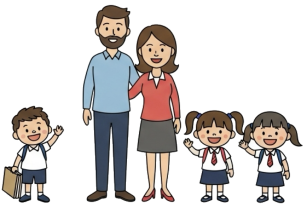
Question More, Action Knowledge.
Remember, at QMAK, we don’t just teach; we empower. We don’t just inform; we inspire. We don’t just question; we act. Become a Gold Member, and let’s unlock your child’s full potential, one question at a time.
![]() Ever noticed how some questions just seem to spark more interesting conversations than others? It all comes down to whether you’re asking open or closed questions. As teachers and parents, understanding this difference can be a real game-changer for engaging kids and nurturing their curiosity.
Ever noticed how some questions just seem to spark more interesting conversations than others? It all comes down to whether you’re asking open or closed questions. As teachers and parents, understanding this difference can be a real game-changer for engaging kids and nurturing their curiosity.
Open Questions: Invitations to Explore
Open questions are like unlocking a door to a whole new world of ideas. They usually start with words like “what,” “why,” and “how,” encouraging kids to really dig deep and share their thoughts. For example, instead of asking “Did you like the book we read?” (which could just get a yes or no), you might say “What did you think about the main character’s choices?” or “Why do you think the author included that plot twist?”
These kinds of questions are golden because they:
Closed Questions: Quick and Focused
On the flip side, closed questions have their place too. These are the ones that can typically be answered with a simple “yes,” “no,” or one-word response. Some examples: “Did you finish your math homework?” or “Can you name the three branches of government?”
Closed questions are handy for:
Integrating Both for Effective Communication
At QMAK, we integrate both open and closed questions to optimize learning and communication. Open questions are used to stimulate curiosity and encourage a thorough exploration of ideas, critical for our “Question More” philosophy. Meanwhile, closed questions help in solidifying concepts and summarizing learning outcomes, aligning with our “Action Knowledge” approach, where understanding is demonstrated through clear, direct responses.
By blending both types of questions, we prepare our students not only to excel academically but also to navigate the complexities of real-world interactions. Understanding when to use each type of question helps in fostering better conversations, deeper relationships, and more effective problem-solving.
Through this balanced approach, QMAK emphasizes the importance of questioning as a powerful tool for education and beyond, ensuring that students are not only informed but also insightful, reflective, and decisive.
Verse 1:
There’s a world of difference, in the questions that we ask
Open or closed, each has a unique task
Open invites exploration, imagination takes flight
Closed seeks confirmation, quick answers in sight
Pre-Chorus:
But in the classroom, we need both in our toolkit
To engage and nurture, every curious kid
Blending them together, is the key to success
Preparing our students, for the real world’s complex
Chorus:
The power of questions, open and closed
Unlocking potential, as knowledge is posed
At QMAK, we integrate, both types with care
To stimulate learning, and insights to share
Verse 2:
Open questions spark, creative problem-solving
Building deeper understanding, connections evolving
Closed questions check, if concepts are clear
Making decisions quickly, when the answer’s near
(Pre-Chorus)
(Chorus)
Bridge:
“Question More” with open, explore ideas with zest
“Action Knowledge” with closed, demonstrate your best
Navigating conversations, relationships, and more
With the power of questions, you’ll open every door
(Chorus)
Outro:
So whether in the classroom, or in life’s grand design
Embrace the power of questions, let your curiosity shine
Open and closed, each has a role to play
In the journey of learning, and the wisdom we convey

Remember, at QMAK, we don’t just teach; we empower. We don’t just inform; we inspire. We don’t just question; we act. Become a Gold Member, and let’s unlock your child’s full potential, one question at a time.